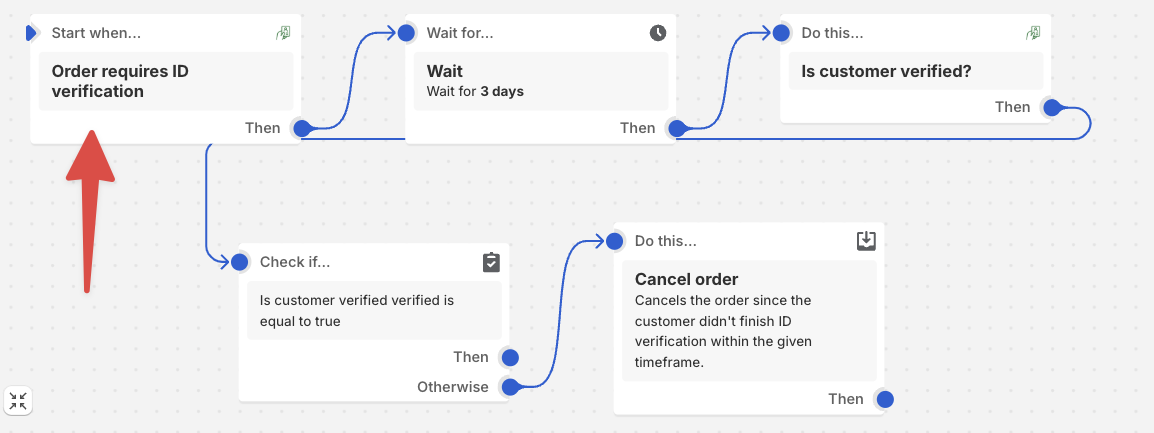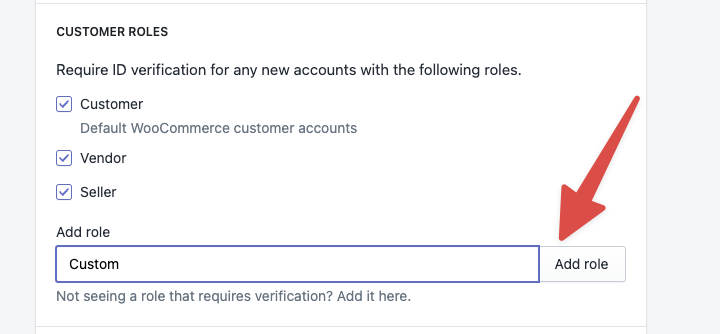Changelog
Find the latest updates and improvements to the Real ID platform.
Introducing automatic customer and order tagging for successful POS ID scans. When customers have their ID scanned at point-of-sale using the POS extension, orders and customers are now automatically tagged with "ID scanned (POS)" and a corresponding metafield is set. This enables merchants to easily identify orders where ID verification was performed in-store, helping with compliance tracking and order management workflows.
Learn moreWe've added a new integration with Helium Customer Fields. This allows you to collect additional customer information during the ID verification process.
Learn more
We've added a new Shopify flow trigger that is fired when an order requires ID verification. This is useful to automate order cancellation or other actions when an order requires ID verification and the customer fails to participate or verify their ID in the allotted time.

We've added support for multiple stores in the Real ID dashboard. This is useful if you have multiple stores and want to switch between them to manage your ID verification workflows.

Now you can define custom roles that should require ID verification. This is useful if you want to verify different types of customers or orders or have a custom workflow for new customers that requires verification before they can view pricing and place orders..

We've released a major improvement to our vision A.I. systems to better detect the use of online duplicates, or example IDs as well as detect photos of photos. This update is being rolled out incrementally to brands.
We've added a new hook to the WooCommerce Real ID plugin. You can now trigger a custom action when the ID verification status of your customers or orders changes. This is useful if you want to trigger a custom action when the ID verification status changes. This can be used to extend the functionality of the Real ID plugin without using webhooks.
Learn moreFilters have been improved to make it easier to find what you are looking for. We've improved the filters system for both the Shopify and WooCommerce platforms. Select multiple ID check statuses to filter by at time. We've also improved consistency in the behavior when selecting multiple filters.

Fixed product variant category detection for ID required category rules. Product variants now properly inherit their parent product's categories when checking if ID verification is required based on category settings. This ensures consistent ID verification triggering for both simple products and product variations.
POS ID barcode scanning for U.S. drivers licenses is now generally available! Scan PDF417 barcodes directly from your Shopify POS device to verify customer age and ID validity in real-time. This feature enables instant ID verification at point-of-sale with automatic age checking and document expiration validation. Successful scans automatically tag customers and orders for streamlined compliance tracking.
Learn moreFixed multiple critical issues in the WooCommerce plugin: corrected email sender signature verification API routes that were causing DNS verification failures, resolved React app crashes when navigating between Settings tabs after license activation, and added automatic recovery for corrupted cache data. These fixes ensure stable plugin operation and smooth admin interface navigation.
Improved user experience for failed barcode scans in the Shopify POS ID scanner. When a barcode scan fails due to incomplete or cut-off data, users now see a clear 'Close' button instead of a non-functional 'Try Again' button. Added explanatory text about Shopify's POS scanner limitations and provided guidance to close and reopen the scanner for retry attempts.
Learn moreExpanded live chat support to more subscription plans and improved the support experience with richer context. Live chat is now available for Pro, Business, Automate, Enterprise, Protect, and Essential plans. Support agents now receive comprehensive context including staff member details, current page, subscription information, and platform identification to provide faster, more targeted assistance.
Merchants now receive email notifications when staff members manually approve ID verifications. These notifications include contextual subject lines that lead with order ID and customer name when available, making it easier to track manual approval activities across your team. This enhancement provides better visibility into staff actions and ensures proper record-keeping for compliance purposes.
New ShipStation integration enables automated order fulfillment based on ID verification status. Merchants can now automatically hold orders requiring ID verification and release them once verification passes. The integration supports custom order status mapping, connection testing, and comprehensive event logging. Orders are searched using WooCommerce order IDs with optional prefix support for seamless synchronization.
Learn moreStreamlined merchant workflow for creating ID checks directly from WooCommerce order details. When merchants click 'Create an ID check' from any order page, the form now automatically populates with customer details (name, email, phone) and skips to the recipient details step. This eliminates manual data entry and searching, making it faster and easier to send ID verification requests for specific orders.
Added custom email subject line functionality to the New ID check form. Merchants can now personalize email subject lines with shortcodes like [firstName], [lastName], and [orderId] for more engaging customer communications. The system auto-populates smart default subjects based on order context and provides real-time preview that matches actual email delivery. Includes collapsible shortcode reference and clean subject line generation without placeholder text when shop names are unavailable.
Enhanced email subject line functionality with autocomplete and localStorage memory. Subject fields now prefill with the most recently used custom subject for faster form completion. Added real-time autocomplete dropdown with keyboard navigation (arrow keys, Enter, Escape) that suggests previously used subject lines while typing. Fixed alignment issues between email subject fields and message content preview for better visual consistency in the new check form.
Significantly improved internationalization support for all supported languages including German, Spanish, French, Italian, Japanese, Dutch, and Portuguese. Fixed missing translation keys and ensured complete localization of the ID verification flow. All user interface elements, feedback messages, and instructional text are now properly translated, providing a seamless experience for customers in their preferred language. This update enhances accessibility and user experience for international merchants and their customers.
Added a new birth_date_iso field to all API responses containing ID verification data. This field provides birth dates in ISO 8601 format (YYYY-MM-DD) alongside the original MM/DD/YYYY format, making it easier to integrate Real ID with modern systems that expect standardized date formats. The new field is available in the /api/v1/checks/[checkId] endpoint, Shopify Flow actions, and all webhook payloads. Full backwards compatibility is maintained with the original birth_date field remaining unchanged.
Learn moreFixed improper handling of customer ID 0 in WooCommerce guest checkout scenarios that was causing incorrect verification behavior. Guest checkout orders (customer ID 0) were being treated as valid customer IDs and incorrectly matched as repeat customers. The fix ensures customer ID 0 (numeric or string) is consistently treated as null for guest checkouts, adds support for both order.customer.id and order.customer_id data formats, and enables proper email-based verification for guest customers. This prevents false positives in repeat customer detection and improves verification workflow accuracy while maintaining full backwards compatibility.